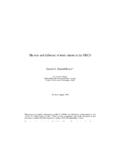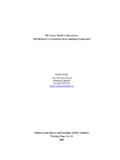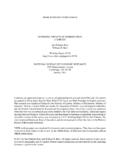Transcription of OECD Economic Surveys Canada
1 OECD Economic Surveys Canada June 2016 OVERVIEW This Overview is extracted from the Economic survey of . The survey is published on the responsibility of the Economic and Development Review Committee (EDRC) of the OECD, which is charged with the examination of the Economic situation of member countries. The statistical data for Israel are supplied by and under the responsibility of the relevant Israeli authorities. The use of such data by the OECD is without prejudice to the status of the Golan Heights, East Jerusalem and Israeli settlements in the West Bank under the terms of international law. This document and any map included herein are without prejudice to the status of or sovereignty over any territory, to the delimitation of international frontiers and boundaries and to the name of any territory, city or area OECD Economic Surveys : Canada OECD 2016 You can copy, download or print OECD content for your own use, and you can include excerpts from OECD publications, databases and multimedia products in your own documents, presentations, blogs, websites and teaching materials, provided that suitable acknowledgment of OECD as source and copyright owner is given.
2 All requests for public or commercial use and translation rights should be submitted to Requests for permission to photocopy portions of this material for public or commercial use shall be addressed directly to the Copyright Clearance Center (CCC) at or the Centre fran ais d exploitation du droit de copie (CFC) at OECD Economic Surveys : Canada OECD 201611 Executive summary Activity is shifting from energy to non-energy sectors in response to price signals Vulnerabilities related to housing and household debt are still increasing, albeitat a slower pace Productivity growth has been weak until recentlyEXECUTIVE SUMMARYOECD Economic Surveys : Canada OECD 201612 Activity is shifting from energy to non-energy sectors in response to price signalsOutput is adjusting to lower commodity pricesThree-month moving average of real outputSource:Bank of Canada (2016),Monetary Policy Report, April; StatisticsCanada, Table 2 Canadian economy is adjusting to the fall incommodity prices, energy in particular.
3 Businessinvestment has fallen sharply in the energy sector,and employment has declined in oil-producingprovinces. These factors, together with the loss ofincome from the fall in the terms of trade,temporarily depressed Economic growth in has fallen sharply in industries most affectedby commodity prices but has risen in the rest of theeconomy, especially in export-related industries,allowing new job creation to re-employ displacedworkers. Exchange rate depreciation, Canada sflexible labour markets and monetary and fiscalpolicy are supporting the shift towards related to housing and household debt are still increasing, albeitat a slower paceHousehold debt and house prices are highSource:Statistics Canada , Table 378-0123; OECD, Economic 2 interest rates have encouraged furtherincreases in household credit, with household debtcontinuing to edge up from already high house prices have risen sharply, especiallyin Vancouver and Toronto, and housing investmentis unusually high as a share of GDP, posingvulnerabilities and squeezing middle-class familiesin these high-priced markets.
4 In response to thesedevelopments, the authorities have deployed sometargeted macro-prudential measures, but furtherregionally focused measures should be growth has been weak until recentlyMultifactor productivity has stagnatedSource:Australian Bureau of Statistics; US Bureau of Labor Statistics;Statistics Canada1 2 has grown more slowly than in thebest performing comparable OECD countries inrecent decades, holding back living standards andwell-being. This weakness in productivity growthis broad based. There are several potentialexplanations, although it is difficult to identify themost important. Among them are high barriers tocompetition in network sectors which impedeinnovation and productivity growth. Interprovincialnon-tariff barriers hamper efficiency, particularly byreducing the scale of production. Improved smallbusiness dynamism, with higher start-up rates andstrengthened up-or-out dynamics , would speed thereallocation of resources to more productive firmsand the diffusion of new technologies, 2013 = 100 Export-related industriesCommodity-prices-sensitive industriesRest of the economy199019952000200520102015801001201 40160180200220%8010012014016018020022019 90 = 100 Household debt/disposable incomeReal house prices1990199520002005201095100105110115 1201251301990 = 100 CanadaAustraliaUnited StatesEXECUTIVE SUMMARYOECD Economic Surveys .
5 Canada OECD 201613 MAIN FINDINGSKEY RECOMMENDATIONSR educing financial stability risksHouse prices, housing investment and household debtare very high, posing financial stability to tighten macro-prudential measures andtarget them regionally, including through increasingcapital requirements in regions with high houseprice-to-income ratios, as growth stronger, greener and more inclusiveThe federal government has a strong fiscal position,with room to support demand in the short term,speed resource reallocation and promote longer-termgrowth and federal investment in physical infrastructure,social housing, education and innovation, as will soon face the pressures from an ageingpopulation and will need to use all available sourcesof labour, including its Indigenous Peoples, whocontinue to face poor social and Economic towards sharing more of the fruits of growthwith Canada s Indigenous Peoples through providingmore resources for their education, training, healthcare, housing, entrepreneurship and environmentalinfrastructure servicing their communities, emissions are high both in per capita termsand relative to GDP, partly reflecting high emissionsfrom road transportation and mining, oil and provinces have made largely uncoordinatedmoves to put a price on carbon governments should act on their recentVancouver declaration to ensure that an adequateprice is placed on carbon emissions across the countryto allow Canada to meet its productivityBarriers to competition in network sectors are high.
6 Which weakens competitive pressures to innovateand adopt new foreign ownership restrictions in airtransportation on a reciprocal basis and in telecomsand broadcasting, where cultural objectives could beachieved by other markets are highly fragmented, with fewcompetitive regional wholesale and retail markets,weakening more east-west interconnections throughprovincial cooperation when there is an Economic caseto do so. Liberalise the generation and distributionsegments to encourage wholesale and retailcompetition in jurisdictions that have not done so interprovincial barriers lower efficiency,particularly by reducing the scale of the Agreement on Internal Trade (AIT) hasreduced such barriers, weaknesses in its frameworkand dispute resolution mechanisms and the absenceof agreements in particular sectors limit the AIT s sectoral coverage as much aspossible.
7 Seek to reconcile remaining regulatorydifferences (possibly via mutual recognition). Establisha pan-Canadian regulatory cooperation council. Raisemonetary penalties for non-compliance, and expeditedispute resolution, which remains breaks to SMEs do not appear to address marketfailures efficiently and insufficiently targetpotentially productive small business taxation ( in the context ofthe recently announced federal tax expenditurereview) to identify clear market failures and the policyinstruments best suited to addressing funded by Labour-Sponsored Venture CapitalCorporations (LSVCCs) underperform those fundedby private venture capital owing to less out remaining federal tax credits for provincialLSVCCs, as previously planned, and explore whether tomake greater use of funds that operate like private,independent, limited partnership venture capital funds,as was the case with the Venture Capital Action Economic Surveys .
8 Canada OECD 201615 Assessment and recommendations Recent Economic developments and near-term prospects Regional adjustments to terms-of-trade declines and policies to facilitatethe sectoral shift Ensuring price and financial stability Fiscal policies to raise the incomes of all Canadians Boosting productivity and living standards Improving environmental policies to promote sustainability and productivityThe statistical data for Israel are supplied by and under the responsibility of the relevant Israeliauthorities. The use of such data by the OECD is without prejudice to the status of the Golan Heights,East Jerusalem and Israeli settlements in the West Bank under the terms of international AND RECOMMENDATIONSOECD Economic Surveys : Canada OECD 201616 The Canadian economy has grown solidly since the turn of the century. The level andincreases in GDP per capita have been similar to rates for the median of the most affluentOECD countries; labour productivity, however, remains lower in Canada (Figure 1, Panels Aand B).
9 Canada also recovered more strongly from the global financial crisis than mostother OECD countries, helped by the impressive rise in commodity prices that wassustained until mid-2014, a comparatively strong recovery in the United States, Canada smain trading partner, a prudent banking system and supportive fiscal and has a large territory (covering nearly 10 million square kilometres), istopographically varied and sparsely populated (population density is only a tenth of theOECD average), even if a large share of the population lives in widely separated large urbancentres. Its people have diverse backgrounds, with one of the world s highest shares ofimmigrants (nearly 20%) and a small but rapidly growing population of Indigenous Peoples(including First Nations, M tis and Inuit), who make up a further 4% of the public responsibilities are devolved to governments of the 10 provinces and threeterritories that comprise the confederation.
10 The provinces main powers are in the areas oftaxation, health care, education, natural resources and energy, environment and labourmarket scores highly in all dimensions of the OECD s Better Life Index (Figure 2,Panel A). Household disposable income and wealth are above the OECD average, whileoutcomes in jobs and earnings and housing are well above average. On the non-economicdimensions, Canada does particularly well in health status but less so in work-life scores are very similar to Australia s, another high-income commodity exporter, exceptin civic engagement and governance, which is lower, and are as good as or better thanthose of the United States in all dimensions except income. Income inequality is slightlybelow the OECD average, reflecting relatively low inequality in gross incomes (thereduction in income inequality through taxes and transfers is less than the OECD average),as is the poverty rate (Panel B).














